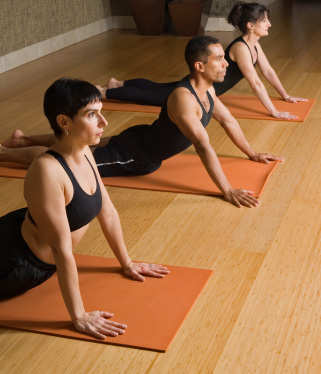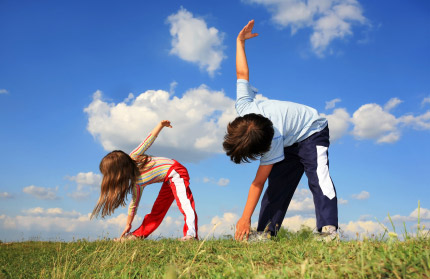 |
 |
|
 One
complaint many people have about their own personal practice is that
they can't seem to get (or keep) it going. Real life, a busy schedule,
kids, or lack of space becomes more pressing than the desire to have a
practice. For other people, the intention is there, but the motivation
seems to elude them. For some people, attending a yoga retreat can
kick-start them into more personal practice, while others tend to just
keep their yoga in the studio where they take classes. One
complaint many people have about their own personal practice is that
they can't seem to get (or keep) it going. Real life, a busy schedule,
kids, or lack of space becomes more pressing than the desire to have a
practice. For other people, the intention is there, but the motivation
seems to elude them. For some people, attending a yoga retreat can
kick-start them into more personal practice, while others tend to just
keep their yoga in the studio where they take classes.
If you
desire to have a yoga practice, then know this: you can have a personal
practice anywhere, anytime. You do not need an in-home studio, you
don't need an hour of devoted time, and you certainly don't have to do
the same thing every day. If you have five minutes upon rising in the
morning do your sun salutations – this is your personal practice. If
you find time on your lunch break to practice balancing in the park,
then that's your yoga practice. Wherever you have the desire to do
yoga, make it happen. If you find yourself on an airplane when the mood
strikes you, then it may just be time to practice some mudras, locks,
or seated meditation.
Instead of holding yourself up to an ideal
where you have a yoga routine that you do daily in some sacred space,
let your yoga happen wherever and however it does. If you fall out of
the habit of doing yoga in your daily life, do not berate yourself or
consider yourself a failure. Instead, stop and stand in tree pose,
remembering that you carry your yoga practice within you. As this
develops further, you may find that there is in fact a space in your
home to devote to your practice, or a time of day that is more
convenient than others. This is good and it will encourage continuing
your practice. Don't get discouraged if there are a few breaks in
between – all things will come in their own time.
|
|
 |
 |
|
Children
are wonderfully suited to yoga practice and benefit from a routine yoga
practice. Young children who are in preschool can usually stay focused
on yoga for ten to fifteen minutes, while those in elementary school
can stay present for twenty to thirty minutes of yoga. With children's
yoga, a focus on light-hearted fun is usually the best approach. All
those animal poses, like cat, cow, cobra, upwards and downwards dog,
and fish pose are great places to start as the children can imitate the
animals in both posture and noise.
 The
physical benefits of yoga for children should not be underestimated.
They gain strength and flexibility all while learning that taking care
of their bodies in a way that is fun and enjoyable. They learn to
respect their bodies and be proud of what they can do. With each
accomplishment, whether it is finally balancing in tree pose for a full
ten breaths or being able to touch their nose to their knees, they gain
self esteem. Learning that hard work and dedication are what lead them
to success is best learned early, and will serve them well for the rest
of their lives. The
physical benefits of yoga for children should not be underestimated.
They gain strength and flexibility all while learning that taking care
of their bodies in a way that is fun and enjoyable. They learn to
respect their bodies and be proud of what they can do. With each
accomplishment, whether it is finally balancing in tree pose for a full
ten breaths or being able to touch their nose to their knees, they gain
self esteem. Learning that hard work and dedication are what lead them
to success is best learned early, and will serve them well for the rest
of their lives.
There is also an emotional component to what
children learn from yoga that affects their ability to interface with
the rest of the world in a more effective manner. They learn the skills
of meditation and relaxation, and how to calm their minds and bodies.
The teachings of yoga are easy for them to assimilate and begin to
practice in their lives. Yoga allows children to express themselves
creatively, to release tension, fear, or sadness they might feel, and
welcome peace and joy into their lives. This can become their pattern,
their learned behavior, and how to live their life.
|
|
 |
 |
|
Over
the past decade, yoga has become a fitness craze. It is offered in many
gyms and fitness centers alongside all the other exercise classes. Many
look to yoga to help them lose weight, gain flexibility, and strengthen
their body. This is all well and good, of course, because yoga does do
all of these things. The true practice of yoga, however, as has been
passed down for centuries through its teachers, is much deeper. A
practice of yoga should bring one to a place of deep inner peace, a
place of deep devotion.
In finding
emotional balance in yoga, the trick is this: experience the yoga.
Allow your entire experience to become the yoga. When you settle into
your own stillness, you realize that this wonderful and peaceful place
is always within you, that it IS you. With practice, you can return to
this state of stillness at any time.

Through
the agility of the body, we may stretch and put ourselves into many
positions, massage all of our internal organs, and amaze ourselves at
the ability of our body, and at the end of the day we will find
our true center.
Practitioners
of yoga will tell you that the best way to increase balance is to
practice balancing. For physical balance, one might start by balancing
on two feet, then one foot, then perhaps on one's arms. These exercises
will also transfer to emotional balance, especially if, as the physical
balance is occurring, the mind practices stillness. If you are thinking
wildly, you do not have mental or emotional balance, and your physical
balance will suffer. If you can calm and center your mind, your
emotions and thoughts will be still, and your physical balance
improved.
|
|
 |
|
|
|
 |
|
In This Issue
|
|
 |
|
Updates from the studio
|
|
Name

Phone
Website
|

|
|
Finding Poses for Your Health
|
|
The
practice of yoga has many benefits, and these come both from the
stretching and strengthening of the body, the calming effects of
meditation on the mind, and the fact that yoga, through the various
poses, is designed to massage the internal organs and glands of the
body to promote healthy function of those systems. A practice of yoga
will certainly improve your all-around health, and if you have any
health issues you would like to address, ask your yoga teacher which
poses will help support, strengthen, and stimulate the parts of your
body that need healing.
|

|
|
Schedule for Mental Clarity
|
|
Being
able to tap into a peaceful calm state on your yoga mat is wonderful,
but what if you could actually arrange your schedule for maximum mental
clarity? Well, you can. The trick is this: before you go to sleep at
night, make yourself a list of everything you need to get done the next
day. Then, go to bed, preferably on the early side. While you sleep
blissfully, your brain will be busy organizing the list in your head
and getting ready for the next day. Rise early. Try to be as productive
as possible in the morning. Give yourself credit for completing
projects on your list. The more you adjust to your new pattern, the
easier it will be to get up and get going in the morning, and the more
time you'll have for yourself to unwind and relax at the end of the
day. You'll use the most energetic part of your day (the morning) to
get things done, and therefore be working more at the peak of your
mental clarity, rather than towards the end of the day when your brain
won't be quite as sharp.
|
|
 |
